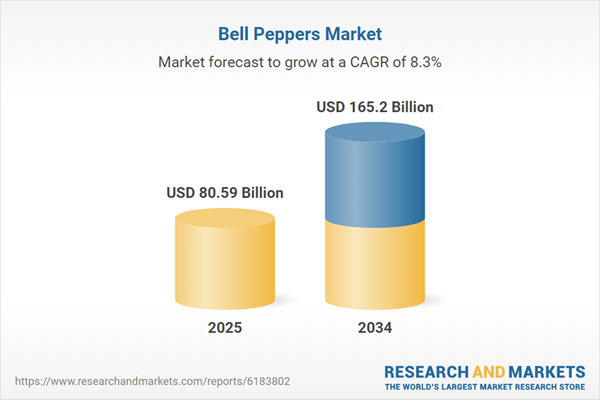Bell Peppers Market
The Bell Peppers Market spans fresh retail, foodservice, and processed formats (sliced, diced, roasted, frozen, dehydrated, puréed) serving home cooking, QSR toppings, meal kits, ready meals, sauces, and salad bars. Consumer preferences center on sweetness, crunch, vivid color assortment (green, red, yellow, orange), and residue-safe, traceable supply. Trends include controlled-environment agriculture, high-brix and thick-wall hybrids, snacking minis, multicolor packs, and clean-label roasted and fire-grilled SKUs for premium meal solutions. Drivers encompass rising at-home culinary experimentation, global cuisines, health-forward positioning (vitamin-rich, low calorie), and retailer focus on shrink reduction and year-round availability. Competitive dynamics pit integrated greenhouse producers and export consortia against open-field growers and packers, with differentiation through varietal IP, sustainability metrics, and service levels. Investments target high-wire greenhouse systems, integrated pest management, beneficials, and automation in seeding, harvesting, and packing. Post-harvest priorities include rapid field heat removal, humidity-controlled storage, ethylene management, and pack formats that balance shelf life with visibility and minimal plastic. Buyers emphasize third-party certifications, social compliance, and data-sharing for demand planning, while processors seek consistent flesh thickness, peelability, and roast behavior for industrial lines. Route-to-market blends direct-to-retail programs, consolidation through produce marketers, and foodservice distributors, supplemented by proximity processing for charred, frozen, and diced ingredients that stabilize pricing and reduce waste.Bell Peppers Market Key Insights
- Year-round continuity through multi-origin programs
- Greenhouse and CEA scale as a quality moat
- Varietal innovation and IP strategy
- Post-harvest and cold-chain discipline
- Sustainability and input efficiency
- Food safety and social compliance as table stakes
- Processed and culinary-ready formats expand margin
- Retail merchandising and pack architecture
- Data-driven demand planning
- Risk management and resilience
Bell Peppers Market Reginal Analysis
North America
Demand is supported by at-home cooking, fresh snacking, and QSR/menu innovation featuring roasted peppers, fajita mixes, and premium toppings. Greenhouse acreage continues to expand, delivering consistent size and color assortment for retail programs. Buyers emphasize food safety verifications, social compliance, and on-time, in-full metrics. Processors near metro hubs scale roasted and diced formats for meal kits and ready meals, reducing freight and shrink risk.Europe
Retailers prioritize residue management, recyclable packaging, and audited labor standards, favoring CEA and integrated grower-packer marketers. Southern European open-field supply dovetails with Northern European greenhouse windows to achieve continuity. Culinary trends emphasize Mediterranean and Middle Eastern dishes, boosting demand for roasted and pointed types. Data-linked promotions and category resets focus on multicolor packs, snacking minis, and convenience cuts for chilled meals.Asia-Pacific
Rising urban incomes and modern retail expansion lift consumption in fresh, stir-fry, and hot-pot formats, alongside growing adoption in Western-style salads and pizzas. Protected cultivation scales in select markets to improve quality and reduce pesticide exposure, while export programs from key producing countries serve regional hubs. Cold-chain strengthening and e-commerce grocery enhance reach, and processors diversify into frozen and roasted SKUs for foodservice.Middle East & Africa
Hospitality and quick-service channels drive steady demand for premium colors and consistent sizing. Greenhouse and shade-house projects expand to ensure year-round availability and heat-stress mitigation. Importers and local producers focus on food safety, water stewardship, and efficient irrigation, while retail growth in modern trade boosts visibility for multicolor packs and snack minis. Proximity roasting and slicing support HORECA requirements.South & Central America
Favorable climates support competitive open-field production, with export gateways supplying North American and European programs alongside domestic retail. Investments in packhouses, pre-cooling, and logistics improve quality on arrival and reduce claims. Processed lines for roasted, IQF, and puréed peppers add value and absorb size and cosmetic variances. Retailers promote multicolor offerings and culinary-ready cuts aligned with evolving home-cooking trends.Bell Peppers Market Segmentation
By Type
- Conventional
- Organic
By Texture
- Orange Bell Peppers
- Purple Bell Peppers
- Red Bell Peppers
- Yellow Bell Peppers
- Others
By Application
- Food Service
- Household
- Food Industrial
By Distribution Channel
- Offline
- Online
Key Market players
Syngenta Vegetable Seeds, Bayer (Seminis & De Ruiter), Rijk Zwaan, Enza Zaden, Sakata Seed, Takii Seed, HM.CLAUSE, East-West Seed, Mastronardi Produce (SUNSET), Mucci Farms, Nature Fresh Farms, Red Sun Farms, Village Farms, Windset Farms, Pure Flavor, Lipman Family Farms, NatureSweet, Oppy (The Oppenheimer Group), Greenyard, Del Monte Fresh ProduceBell Peppers Market Analytics
The report employs rigorous tools, including Porter’s Five Forces, value chain mapping, and scenario-based modelling, to assess supply-demand dynamics. Cross-sector influences from parent, derived, and substitute markets are evaluated to identify risks and opportunities. Trade and pricing analytics provide an up-to-date view of international flows, including leading exporters, importers, and regional price trends.Macroeconomic indicators, policy frameworks such as carbon pricing and energy security strategies, and evolving consumer behaviour are considered in forecasting scenarios. Recent deal flows, partnerships, and technology innovations are incorporated to assess their impact on future market performance.
Bell Peppers Market Competitive Intelligence
The competitive landscape is mapped through proprietary frameworks, profiling leading companies with details on business models, product portfolios, financial performance, and strategic initiatives. Key developments such as mergers & acquisitions, technology collaborations, investment inflows, and regional expansions are analyzed for their competitive impact. The report also identifies emerging players and innovative startups contributing to market disruption.Regional insights highlight the most promising investment destinations, regulatory landscapes, and evolving partnerships across energy and industrial corridors.
Countries Covered
- North America - Bell Peppers market data and outlook to 2034
- United States
- Canada
- Mexico
- Europe - Bell Peppers market data and outlook to 2034
- Germany
- United Kingdom
- France
- Italy
- Spain
- BeNeLux
- Russia
- Sweden
- Asia-Pacific - Bell Peppers market data and outlook to 2034
- China
- Japan
- India
- South Korea
- Australia
- Indonesia
- Malaysia
- Vietnam
- Middle East and Africa - Bell Peppers market data and outlook to 2034
- Saudi Arabia
- South Africa
- Iran
- UAE
- Egypt
- South and Central America - Bell Peppers market data and outlook to 2034
- Brazil
- Argentina
- Chile
- Peru
Research Methodology
This study combines primary inputs from industry experts across the Bell Peppers value chain with secondary data from associations, government publications, trade databases, and company disclosures. Proprietary modeling techniques, including data triangulation, statistical correlation, and scenario planning, are applied to deliver reliable market sizing and forecasting.Key Questions Addressed
- What is the current and forecast market size of the Bell Peppers industry at global, regional, and country levels?
- Which types, applications, and technologies present the highest growth potential?
- How are supply chains adapting to geopolitical and economic shocks?
- What role do policy frameworks, trade flows, and sustainability targets play in shaping demand?
- Who are the leading players, and how are their strategies evolving in the face of global uncertainty?
- Which regional “hotspots” and customer segments will outpace the market, and what go-to-market and partnership models best support entry and expansion?
- Where are the most investable opportunities - across technology roadmaps, sustainability-linked innovation, and M&A - and what is the best segment to invest over the next 3-5 years?
Your Key Takeaways from the Bell Peppers Market Report
- Global Bell Peppers market size and growth projections (CAGR), 2024-2034
- Impact of Russia-Ukraine, Israel-Palestine, and Hamas conflicts on Bell Peppers trade, costs, and supply chains
- Bell Peppers market size, share, and outlook across 5 regions and 27 countries, 2023-2034
- Bell Peppers market size, CAGR, and market share of key products, applications, and end-user verticals, 2023-2034
- Short- and long-term Bell Peppers market trends, drivers, restraints, and opportunities
- Porter’s Five Forces analysis, technological developments, and Bell Peppers supply chain analysis
- Bell Peppers trade analysis, Bell Peppers market price analysis, and Bell Peppers supply/demand dynamics
- Profiles of 5 leading companies - overview, key strategies, financials, and products
- Latest Bell Peppers market news and developments
Additional Support
With the purchase of this report, you will receive:- An updated PDF report and an MS Excel data workbook containing all market tables and figures for easy analysis.
- 7-day post-sale analyst support for clarifications and in-scope supplementary data, ensuring the deliverable aligns precisely with your requirements.
- Complimentary report update to incorporate the latest available data and the impact of recent market developments.
This product will be delivered within 1-3 business days.
Table of Contents
Companies Mentioned
- Syngenta Vegetable Seeds
- Bayer (Seminis & De Ruiter)
- Rijk Zwaan
- Enza Zaden
- Sakata Seed
- Takii Seed
- HM.CLAUSE
- East-West Seed
- Mastronardi Produce (SUNSET)
- Mucci Farms
- Nature Fresh Farms
- Red Sun Farms
- Village Farms
- Windset Farms
- Pure Flavor
- Lipman Family Farms
- NatureSweet
- Oppy (The Oppenheimer Group)
- Greenyard
- Del Monte Fresh Produce
Table Information
| Report Attribute | Details |
|---|---|
| No. of Pages | 160 |
| Published | November 2025 |
| Forecast Period | 2025 - 2034 |
| Estimated Market Value ( USD | $ 80.59 Billion |
| Forecasted Market Value ( USD | $ 165.2 Billion |
| Compound Annual Growth Rate | 8.3% |
| Regions Covered | Global |
| No. of Companies Mentioned | 20 |









